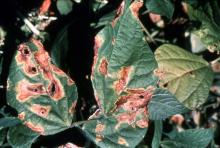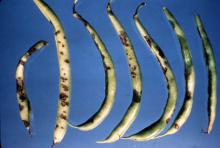By D. H. Gent and C. M. Ocamb
Cause Xanthomonas axonopodis pv. phaseoli (syn. = X. campestris pv. phaseoli), a bacterium that overwinters in contaminated seed, infested crop debris, and is present in and on weeds. The pathogen can be found on the leaves of many plants, but only causes disease on bean. Rain, irrigation water, tools, equipment, and humans can spread the pathogen. Infection occurs when bacterial cells are deposited onto leaves by splashing water, aerosols, or from contaminated seed, and then multiply to form large populations. The bacteria gain entry into plants through natural openings and wounds. Infection occurs most readily during warm (greater than 85ºF), wet weather, especially by hard, wind-driven rains. Bacteria are disseminated within and among fields by splashing water, aerosols, and on contaminated equipment and workers. The pathogen can attack all types of bean, but some kidney bean varieties (Sacramento light red kidney) are especially susceptible.
Symptoms Disease symptoms first appear as flaccid, small water-soaked spots on the underside of leaflets. These spots enlarge and merge, becoming dried and brown. A narrow, bright lemon-yellow border of tissue encircles the lesion. Infected pods develop circular water-soaked spots, and yellow masses of bacteria may appear at their center. Later, the spots dry and become reddish-brown, sunken lesions. Early pod infection causes shriveled seeds, and the bacteria may cause yellow to orange discoloration under the seed coat of infected seeds. A stem girdling or joint rot occurs above the cotyledonary node of plants grown from infected seeds. The disease may reduce seed yield, size, and quality.
Visually inspecting seed to detect contamination is unreliable because seeds may appear healthy but be heavily contaminated. Severely diseased seeds may be shriveled or discolored.
Cultural control
- Plant certified seed free from the pathogen.
- If pathogen-free seed cannot be obtained, delay planting until dry weather prevails, if possible.
- Avoid frequent irrigations with sprinklers.
- Do not work in diseased fields that are wet with rain or irrigation water.
- Use a 2- to 3-year or longer crop rotation.
- Plow under plant debris as soon as possible after harvest to allow time for debris to decompose during winter.
Chemical control Bactericides at 7- to 10-day intervals may slow disease spread if it is at low levels in the field.
- Copper formulations (Group M1) offer limited control.
- Badge SC at 0.5 to 2 pints/A on 7- to 14-day intervals. Preharvest interval is 0 days. 48-hr reentry.
- Bonide Liquid Copper is available for home gardens. H
- Champ WG at 1.58 lb/A on 7- to 14-day intervals. Preharvest interval is 0 days. 48-hr reentry. O
- Cuprofix Ultra 40 Disperss at 0.75 to 2 lb/A on 7- to 14-day intervals. 48-hr reentry.
- Cueva at 0.5 to 2 gal/100 gal water on 7- to 10-day intervals. May be applied on the day of harvest. 4-hr reentry. O
- Kocide 2000 at 0.75 to 2.25 lb/A or Kocide 3000 at 0.5 to 1.25 lb/A. 48-hr reentry. O
- Nu-Cop 50 DF at 1 to 1.5 lb/A on 7- to 14-day intervals. 48-hr reentry. O
- Previsto at 1 to 2 quarts/A on 7- to 14-day intervals. 48-hr reentry. O
- Regalia (Group P5) at 1 to 4 quarts/A plus another fungicide on 7- to 10-day intervals. Does not benefit from the addition of an adjuvant. Preharvest interval is 0 days. 4-hr reentry. O
Biological control Efficacy unknown in Oregon.
- Heads Up at 0.035 oz/34 fl oz water/360 lb seed will stimulates pest suppression system of plants. Efficacy unknown. 12-hr reentry. O



